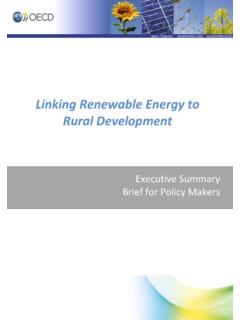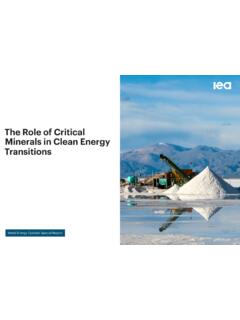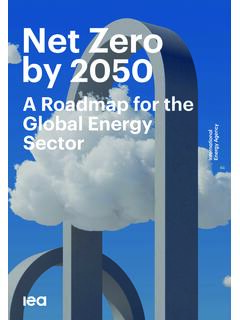Transcription of Energy - OECD
1 OECD Green Growth Studies OECD Green Growth Studies Energy The OECD Green Growth Strategy aims to provide concrete recommendations and measurement tools, including indicators, to support countries' efforts to achieve economic growth and development, while ensuring that natural assets continue to provide the resources and environmental services on which well-being relies. OECD Green Growth Studies The strategy proposes a flexible policy framework that can be tailored to different country circumstances and stages of development. This report was coordinated with the International Energy Agency (IEA). Contents Energy Chapter 1. Transforming the Energy sector to sustain growth Green growth requires a green engine Addressing systemic risks and imbalances Global Energy outlook Implications of continuing current trends Chapter 2.
2 Promoting the transition to green growth Green growth and Energy : What's at stake Potential trade-offs and adjustment costs Key technologies for green growth and Energy A policy framework for greening Energy Policies for green growth in specific Energy sectors Chapter 3. Implementing green Energy : Reshaping the political economy Political economy achieving change in different country contexts Structural adjustment Stranded capital Employment effects Distributional effects Chapter 4. Monitoring progress towards green growth The OECD framework for green growth indicators Energy related green growth indicators Energy ISBN 978-92-64-11510-1. 97 2011 08 1 P. -:HSTCQE=VVZVUV: PRELIMINARY VERSION. FOREWORD. Foreword Global demand for Energy is increasing rapidly, because of population and economic growth, especially in emerging market economies.
3 While accompanied by greater prosperity, rising demand creates new challenges. Energy security concerns can emerge as more consumers require ever more Energy resources. And higher consumption of fossil fuels leads to higher greenhouse gas emissions, particularly carbon dioxide (CO2), which contribute to global warming. At the same time, the number of people without access to electricity remains unacceptably high. But such challenges can create opportunities. A sustainable Energy future will require new thinking and new systems essentially a transformation in the way we produce, deliver and consume Energy . If our goal is to raise living standards, provide access to modern Energy services, use Energy more efficiently, protect the global environment and ensure reliable Energy supplies, green growth must play a key role.
4 The OECD and IEA are actively supporting the transition to a greener model of growth. At its 50th Anniversary Ministerial Council Meeting in May 2011, the OECD launched a Green Growth Strategy to help policy makers and stakeholders to address the major environmental challenges of today's world, while expanding economic opportunities. The Strategy encompasses both policy recommendations to make economic growth greener and a set of indicators to monitor progress towards green growth. The Strategy is first and foremost about implementing change and achieving a common purpose: a world that is stronger, cleaner, and fairer. This report highlights the challenges facing Energy producers and users, and how they can be addressed using green growth policies. Because Energy underlies the global economy, the decisions made today in the Energy sector will be critical to achieving greener growth.
5 We have a window of opportunity for establishing a policy framework to enable transformational change in the Energy sector , including by facilitating technological innovation and the creation of new markets and industries, to reduce the sector 's carbon-intensity and to improve Energy efficiency. The environmental imperative to reduce CO2, emissions in the Energy sector coincides with a looming new investment cycle in power generation in most OECD countries. In the emerging market economies, many power generation facilities are quite recent, but many more will be built in the coming years to meet growing Energy demand. As power plants and other infrastructure tend to have long operating lives, we must avoid lock-in of CO2. emissions by ensuring the latest clean technologies are used.
6 We have a narrow margin. If we do not manage to slow current rates of emissions growth, we will hit the ceiling by 2017, meaning that to keep the global increase in temperature to 2 degrees Celsius; all new infrastructure will have to be zero-emission. A large-scale transformation of the global Energy sector is possible, although it will require significant investment. Global emissions could be halved by 2050, using existing and emerging technologies, at an additional cumulative investment of USD 46 trillion, a further increase of 17% on top of baseline investments. It is vital for governments to create an enabling policy framework to catalyse private- sector investment in the transition to a low- carbon Energy sector . By acting now, long-term costs can be reduced. Every US dollar that is not spent on investment in the Energy sector before 2020 will require an additional USD to be spent after 2020 to compensate for increased greenhouse gas emissions by building zero-carbon plants and infrastructure by 2035.
7 There is an urgent need to create an enabling policy framework for the transformation of the Energy sector . The task is daunting, but we must act together and now to create the momentum for fundamental change. Angel Gurr a, OECD Secretary-General and Maria Van der Hoeven, IEA Executive Director OECD GREEN GROWTH STUDIES: Energy OECD 2011 1. ACKNOWLEDGEMENTS. Acknowledgements This preliminary OECD/IEA study has been prepared in the context of the follow-up work to the Green Growth Strategy and is part of the OECD Green Growth Studies series. The present report was prepared by Nathalie Girouard, Elianna Konialis, Cecilia Tam and Peter Taylor drawing significantly on the work developed by three consultants: Barbara Buchner, Debra Justus and William Blyth. Contributions were received from both IEA and OECD experts including Ingrid Barnsley, Amos Bromhead, Jan Corfee-Morlot, Rob Dellink, Dan Dorner, Rebecca Gaghen, Nick Johnstone, Myriam Linster, Bertrand Magn , and Robert Tromop.
8 The report draws from a number of IEA and OECD publications including the Environmental Outlook to 2050, the World Energy Outlook 2011 and the 2010 Energy Technology Perspectives. The report is released under the responsibility of the OECD Secretary-General and the IEA Executive Director. The process was conducted under the leadership of the Chief Economist and Deputy Secretary- General Pier Carlo Padoan and benefitted from the guidance of Bo Diczfalusy, Director, Sustainable Energy Policy and Technology and Simon Upton, Director, Environment Directorate. The project has been managed by Nathalie Girouard and supported by the Green Growth team. Member and partner countries as well as business and civil society provided valuable feedback on previous drafts of the report . For more information on the OECD Green Growth Strategy, see OECD GREEN GROWTH STUDIES: Energy OECD 2011 3.
9 TABLE OF CONTENTS. Table of contents Foreword .. 1. Acknowledgements .. 3. Acronyms .. 3. Executive summary .. 5. Chapter 1. Transforming the Energy sector to sustain growth .. 9. Green growth requires a green engine .. 10. Addressing systemic risks and imbalances .. 13. World Energy outlook .. 14. Implications of continuing current trends .. 20. Chapter 2. Promoting the transition to green growth .. 23. Green growth and Energy : What's at stake .. 24. Potential trade-offs and adjustment costs .. 26. Key technologies for green growth and Energy .. 28. A policy framework for greening 31. Policies for green growth in specific Energy 45. Chapter 3. Implementing green Energy : Reshaping the political economy .. 57. Political economy achieving change in different country contexts .. 58. Structural adjustment.
10 62. Stranded 66. Employment effects .. 70. Distributional 74. Chapter 4. Monitoring progress towards green growth .. 85. The OECD framework for green growth indicators .. 86. Energy related green growth indicators .. 86. OECD GREEN GROWTH STUDIES: Energy OECD 2011 3. TABLE OF CONTENTS. Boxes Box Power capacity additions: Exploiting opportunities and avoiding lock-in .. 12. Box Environmental-economic modelling at the IEA and OECD .. 15. Box How to make a better and greener building 31. Box Lessons from the EU Emissions Trading Scheme .. 35. Box Sample of recent national Energy efficiency programme investments .. 37. Box The Low Carbon Energy Technology Platform .. 42. Box Policy action for smart grids .. 47. Box Biofuels and the food versus fuel 49. Box France's strategy to launch electric vehicles.

















